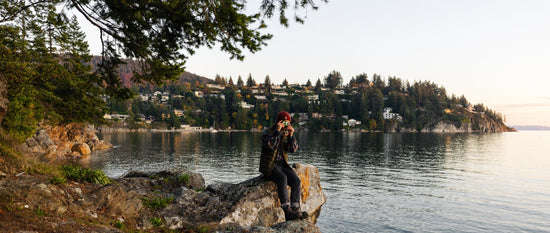You’re new to backpacking, eager to hit the trails and get amongst it. But what’s required? Good gear, a solid route plan, and plenty of snacks. Simple.
Well, there’s a little more to it than that. In this guide, we are going to talk all things backpacking in preparation for sunrise strolls through the peaks, group walks in the woods, and long-distance treks along rugged coastlines.
Backpacking is for everyone. A shared (or solo) experience that promises stunning views, new experiences, and plenty of stories for fireside debriefs. With that, let’s get into a little more on where to go, what to pack, and why it’s best to be a little over-prepared.

Contents
An Intro To Backpacking
At its core, backpacking is a simple, attainable, and low-impact way to explore our natural surroundings. It’s not about the distance covered or destination, but the adventures had along the way.
When backpacking, a few essentials include a sturdy backpack, a reliable pair of boots, and a lightweight sleep setup (if trekking for multiple days). It’s also worth thinking about how you’re going to map out the route, and if you’re opting for an OS map, GPS tracker, or mobile app. We recommend checking out Komoot, All Trails or Strava - all suited to beginner backpackers.
Also take note of the ‘Leave No Trace’ principles and be sure to pack an abundance of snacks, water, and maybe even a brewski to mark the end of your first backpacking trip. For a few more tips and tricks, it’s well worth giving our Backpacking Essentials Checklist a read - so stick the kettle on and let’s get into it.

9 Top Tips For Beginners
Plotting Your Route
For newbies to backpacking, we recommend plotting a route that will scratch the itch of adventure without pushing you too far the first time around. It’s all about building confidence and getting into a rhythm over time, not rushing into anything too soon.
In the UK, there are heaps of waymarked trails that are well worth exploring:
- West Highland Way (Scotland): A 96-mile trail with stunning vistas, wild camp spots, and a well-mapped route.
- South Downs Way (England): A 100-mile route offering gentle terrain, rolling hills, and incredible views across the South of England.
- Cotswold Way (England): A 102-mile walking trail, with plenty of pubs and picturesque villages en route.
- Pembrokeshire Coast Path (Wales): A 186-mile trail, taking in a mix of rugged clifftops, sandy beaches, and manageable daily distances.
- Yorkshire Dales Three Peaks (England): A steep 24-mile circuit, offering some pretty epic ascents amongst the Yorkshire Dales.
Why not get the whole crew together? Shoot the breeze, share the load, and snap some epic shots along the way. Walking as a group can also make a real difference if someone gets into danger.
When it comes to camping on a multi-day hike, try to give yourself ample time to set up before the night sets in, pack a second set of warm clothes, and be sure to stick your head out of the tent and take in the stars - it’s a beaut.

Looking Ahead
Before departure, it’s well worth taking note of the terrain, local wildlife, and any potential dangers that you may encounter along the way. And don’t forget to do a final weather check!
Advice from local hikers is well worth it. They’ll know the best spots to watch the sunset, any sketchy lengths of trail, and rare species worth looking out for along the way.


Prep Work
A small amount of training may be required pre-hike, but this is dependent on the length of the backpacking trip planned and the terrain underfoot. If you have a set goal in mind or a good few miles to cover, we’d advise a little bit of prep work.
However, there are no hard-and-fast rules here. Everyone’s different. It’s more about getting to grips with your gear, getting used to the weight of a full pack, and getting going when your legs start to feel like jelly - day three can be a killer...

Finding Your Way
Even if a trusty route tracker app is your ‘compass’ of choice, having a basic understanding of map reading and trail markers is super important. This will keep you on track (literally) and can lead to a more enjoyable backpacking trip when opting for physical maps and trail books over a digital display. Whatever floats your boat!
A few basic skills to hone in before hitting the trail include:
- Map reading: Being able to interpret a map in good detail is super helpful when over uneven terrain, or when the trail becomes a little tricky to find underfoot.
- Compass use: This will help with your map reading and plotting a general heading in low cloud cover.
- Trail identification: Familiarise yourself with the type of trail markers to expect on your trip - blue, red, arrow, circle, short, tall - you get the idea.

Gear To Get You There
The right gear can be the difference between a backpacking trip to remember, and one that’s best forgotten. Don’t skimp on the essentials! The right backpack, reliable tent, sleeping gear, and lightweight layers are a must:
- Give your feet a little love. A quality pair of moisture-wicking socks, a fully-stocked blister kit, and ample time to break in your hiking shoes is a good start.
- Layer up. It sounds like a classic parental nag, but it’s a great bit of advice. Light layers that you can easily pack away work great in all conditions.
- Water And More Water. It’s vital to stay hydrated when out backpacking, so make sure to take a refillable water bottle with plenty to spare. Plus a purification system (filter, tablets, or a UV purifier) if clean drinking water is going to be hard to find.
Meal Prep
When planning out your meals, it’s good to consider factors like weight, nutrition, and ease of preparation. Here are a couple of ideas for main meals, plus some snacks to keep morale high - an easily accessible, emergency chocolate stash is a big YES:
Breakfast:
- Instant oatmeal: Lightweight and quick to prepare. Just add hot water.
- Granola: A high-energy option with good flavour.
- Snack bars: Convenient and packed with nutrients, especially if you make them yourself with oats, nuts and fruit the night before...
- Dried fruits: Compact and full of natural sugars.
- Coffee or tea bags: For that morning caffeine hit.
Lunch:
- Tortilla wraps: We recommend cheese, peanut butter, or hummus fillings.
- Instant soup or ramen: Lightweight and doubles as a hand-warmer.
- Couscous salad: Pre-make a salad mix with frozen veg and add water on the trail.
- Beef jerky or veggie alternative: High-protein and surprisingly moreish.
Dinner:
- Lunch leftovers: Any pre-made meals to save a little time.
- Instant rice: Pair with canned tuna or dehydrated veg.
- Veggie crisps: Easy to make at home before departure day.
- Plant-based proteins: Lightweight alternatives for the veggies and vegans among us.
- Condiments: Packing small containers of salt, pepper, or hot sauce is a game changer.
Snacks:
- Trail mix: A backpacking classic.
- Energy bars: Compact and worth putting in easily accessible pockets. Extra points for making your own the night before.
- Crackers: With cheese or nut butter for a quick snack.
- Chocolate and sweets: For a quickfire sugar boost.

Pack With Purpose
It’s always worth going for the eco-conscious gear option, whether it be biodegradable soap, recycled cotton tees, or reusable sandwich wraps. This means you’ll have a lessened impact on your surrounding environment when out backpacking on the trail.
We’re not here to judge your packing technique, but a simple rule of thumb is to cram the big items (tent, sleeping bag etc.) at the bottom, with stuff that you need quick access to at the top (thinking wet weather gear, water, and navigational bits). Also, make sure to use the attachment points on the exterior of the bag - the more carabiners = the cooler the pack.


Safety First
Always have a Plan B, definitely a Plan C, maybe even a Plan D. You never know what could happen out on the trail, and you might find yourself in a spot of bother a good few miles from the nearest town or village.
Packing a first-aid kit, multi-tool, head torch, and reliable communication device (satellite phone if appropriate) is a must. Plus a few spare batteries just in case. It’s good to also get in the habit of sharing your itinerary and ETAs with a trusted friend or family member - dropping them a line whenever you can along the way.

Enjoy The Journey
- Embrace the unknown: Be prepared to be, well, unprepared.
- Know your limits: Listen to your body and take it easy. There’s no set amount of miles to cover, competitive step counts, or medal at the finish line. If it doesn’t feel quite right this time around or you pick up a niggle, don’t fret. The trail ain’t going anywhere.
- Take it all in: Don’t forget to slow down, look around, and take each step as it comes. It’s not every day that the to-do list is reduced to putting one foot in front of the other. Make it count.
Final Thoughts Before You Go…
So, there you have it! Passenger’s beginner guide to backpacking. Expect adventure, fireside storytelling, and some seriously tired legs. Stay safe, keep truckin’, and be on your way.

FAQs
What is the difference between backpacking and hiking?
Hiking is usually seen as a one-day deal, either taking a circular route or straight-line trail with minimal gear. Backpacking is a multi-day affair, carrying all of your gear with you and camping along the way.
What is the best country for backpacking beginners?
The UK is entangled with many trails and long-distance walking paths, as is the East Coast of the US, Central Europe, and New Zealand.
Where are some great places in the UK for beginners to go backpacking?
If you’re new to the UK backpacking scene, we recommend the Lake District National Park. Its trails are well-marked, it's stunning, and also pretty easy to access.
What distance is recommended for a first backpacking trip?
For first-timers, a solid goal is to cover 5-7 miles in a day. Maybe try a few day hikes to start, before progressing to full-on backpacking adventures.
When backpacking, should I bring a map or a GPS?
If in doubt, bring both. The map for a super zoomed-out view, while the GPS gives a solid reference point to stay on track.
What do I do if I get lost while backpacking?
If you do happen to get lost, try to stay calm and get your bearings back. If you feel confident to retrace your steps, then go for it. But if not, find a safe spot and signal for help.



Share:
Layers of Escapism: Our Outdoor Active Gear
Made To Roam: What To Wear Backpacking